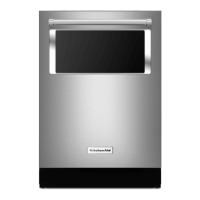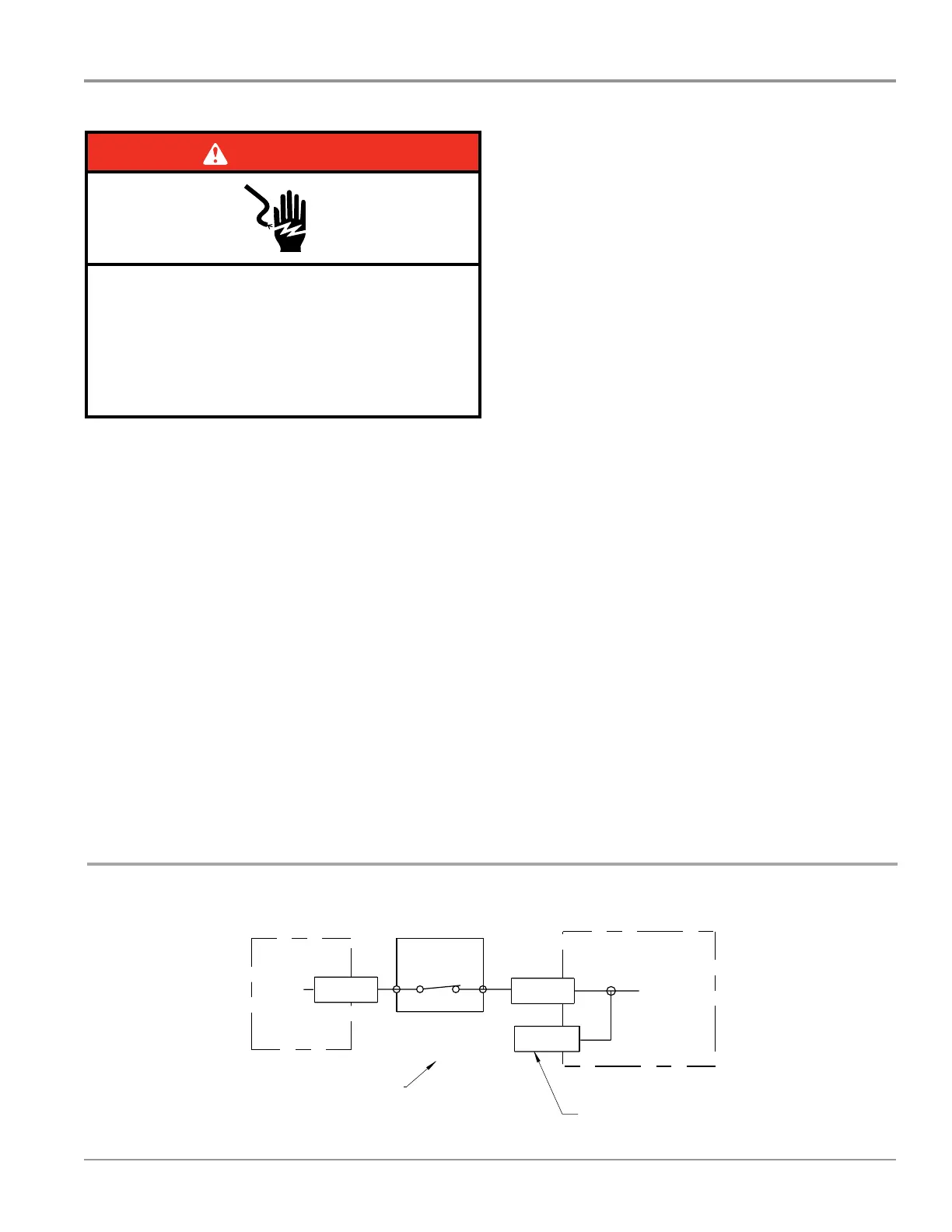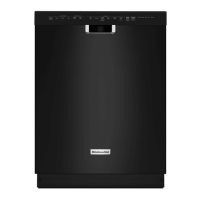TESTING
KitchenAid 2015 Microltration Dishwashers
n
6-13
For Service Technician Use Only
DANGER
Electrical Shock Hazard
Only authorized technicians should perform
diagnostic voltage measurements.
After performing voltage measurements,
disconnect power before servicing.
Failure to follow these instructions can result in
death or electrical shock.
Diverter Sensor/Posion Switch
This test will check the wiring to the diverter sensor/posion
switch and the diverter assembly itself. The following items are
part of the diverter sensor/switch circuit.
n Harness/Connecon
n Diverter Motor (see test on previous page)
n Diverter Sensor/Posion Switch
n Control Board
Test Procedure
1. Check the operaon of the diverter motor in the Service
Diagnosc Cycle. You should be able to “hear” the cam
clicking as it rotates through the following wash zones.
¾ Interval 22, the diverter motor is acvated and water is
‘diverted’ to upper spray arm.
¾ Intervals 18 & 17, the diverter motor will be on
connuously.
¾ Interval 14, the diverter motor is acvated and water is
‘diverted’ to the Turbo Zone (some models only).
¾ Interval 13, the diverter motor is acvated and water is
‘diverted’ to lower spray arm.
Strip Circuit – Diverter Switch
2. If the diverter is diverng the ow of water to the wash
zones, the diverter motor is working–connue to step 3.
If not, perform the diverter motor test procedure on the
preceding page.
3. Unplug dishwasher or disconnect power.
4. Remove toe and access panels to access control board.
5. Visually check that the diverter posion switch connector
and P11 connector on the control are securely installed.
¾ If visual check passes, go to step 6.
¾ If any of the connectors are not inserted properly,
reconnect and retest diverter posion switch.
6. Check connuity of harness between diverter posion
switch and P11 on control.
¾ If connuity test is good, connue to step 7.
¾ If connuity test fails, repair or replace harness as
needed.
7. To test diverter switch, unplug connector P11 from control
board and connect an ohmmeter across pins 3 and 4 (on
the connector removed, not the control board).
8. Plug in dishwasher or reconnect power.
9. Run the service diagnosc cycle as stated in Step 1, and
during the intervals listed, you should observe the diverter
posion switch closing momentarily and then reopening
as it reaches each potenal posion.
¾ If the switch is funconing normally (approximately 3
ohms or less when closed), proceed to step 10.
¾ If switch does not open or close properly, or resistance
is much greater 3 ohms when closed, then replace
diverter assembly and retest.
10. If the preceding steps did not correct the diverter/posion
switch problem, replace the control board and retest.
11. Reassemble all parts and panels.
12. Plug in dishwasher or reconnect power and run Diagnosc
Cycle to verify repair.
5
Drain
Dispenser (Detergent and Rinse Aid)
Diverter Valve
Water Softener
Controlled Lower Spray Arm (on some models)
Drying
For Heated Dry, heater is also running. See “Heater” circuit under “Water Heating/Heat Dry and Water Sensing with O.W.I. Sensor (Water/Air/Soil/Temperature)”.
L1
BK
P4-2
P6-3
P10-1
P6-1
P4-1
BR BR WH
N
Use top hole of jumper
W2 as test point for F9.
N.O.
K2
Pilot L1 Relay
(Also see Door
Switch Circuit)
Fuse
F9
Electronic Control
Electronic Control
No test pad on P6-3.
Recommend using test pad on P10-1.
Pin 1
Pin 3
Drain Motor
15
Ω
- 25
Ω
120V, 60 Hz, 45W
Triac
N
WH
P4-1
Pin 1
Pin 3
Electronic Control
Use top hole of jumper
W2 as test point for F9.
N.O.
K2
Pilot L1 Relay
(also see Door
Switch Circuit)
P4-2 P9-3 P9-1
BK
L1
V
V
P10-1
Fuse
F9
Dispenser Wax Motor
1.4K
Ω
- 2.8K
Ω
120V, 60 Hz, 10W
Pin 1
Pin 5
Test pad on P9-3 might crowd P9-1.
Recommend using test pad on P10-1.
Dispenser Solenoid
260
Ω
- 300
Ω
120V, 60 Hz, 17W
Electronic Control
Triac
Electronic Control
Sensor
Input
ily
and then reopens as the div
erter
reaches each potential div
erter position.
Diverter
Position
Switch
Electronic Control
No test pad on P11-3.
Recommend using test pad on P11-2.
P11-4
P11-3
P11-2
5V
N.O.
Diverter Sensor
Diverter Motor
L1
BK
P4-2 P7-4
P10-1
P7-6
P4-1
N
WHBU
BU
Pin 3
Pin 1
Use top hole of jumper
W2 as test point for F9.
N.O.
K2
Pilot L1 Relay
(Also see Door
Switch Circuit)
Fuse
F9
Electronic Control
No test pad on P7-4.
Recommend using test pad on P10-1.
Electronic
Control
Triac
Dispenser Valve Motor
1,300
Ω
- 1,600
Ω
120V, 60 Hz, 3W
L1
Regeneration Valve
BK
P4-2
P7-3
P10-1
P7-1
P4-1
N
WH
VV
Use top hole of jumper
W2 as test point for F9.
K2
Pilot L1 Relay
(Also see Door
Switch Circuit)
Fuse
F9
Pin 1
Pin 3
N.O.
Electronic Control
Electronic
Control
Triac
No test pad on P7-3.
Recommend usin
ad on P10-1.
Regeneration Valve
890
Ω
- 1,090
Ω
120V, 60 Hz, 6W
Electronic Control
P11-2
P11-1
RD
RD
(RD)
N.O.
N.O.
5V
(Optional Flowmeter)
Sensor
Input
(Closed when salt low)
Salt Level Reed Switch
39 K
Ω
Salt Level Sensing
Pin 1
Pin 1
Pin 4
Pin 2
Pin 3
Pin 3
Electronic
Control
(RD)
RD
RD
RD
RD
RD
WH
Lower Spray Arm Motor
K2
Pilot L1 Relay
(also see Door
Switch Circuit)
Electronic Control
No test pad on P8-3. Recommend using
test pad on P10-1.
(BU stripe
on plug)
(BU stripe
on plug)
(BU stripe
on plug)
Spray Arm Motor
1,890 - 2,310
Ω
each coil
120 V, 60 Hz, 6 Watts
Controlled Lower Spray Arm Sensor
P1A-17
P1A-19
P1A-20
RD
L1
BK
P4-2 P10-1
P10-3
P4-1
BR BR WH
N
Use top hole of jumper
W2 as test point for F9.
N.O.
K2
Pilot L1 Relay
(Also see Door
Switch Circuit)
Fuse
F9
Electronic Control
Electronic Control
(Red stripe
on plug)
(Red stripe
on plug)
Pin 5
Pin 1
Vent Wax Motor
600
Ω
- 1,800
Ω
120V, 60 Hz, 6W
Electronic Control
Electronic Control
(Red stripe
on plug)
(Red stripe
on plug)
P10-5
P10-4
P11-5
DC Ref
BR
BR
Pin 1 Pin 3
Fan Motor
31K
Ω
- 41K
Ω
5 VDC, 1W
Must measure resistance
with correct polarity and
disconnected from controls.
No test pad on P10-4.
Recommend using test pad on P11-5.
5V
_
+
Vent
Fan

